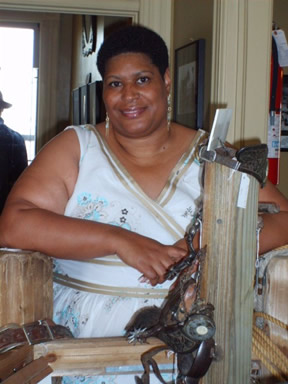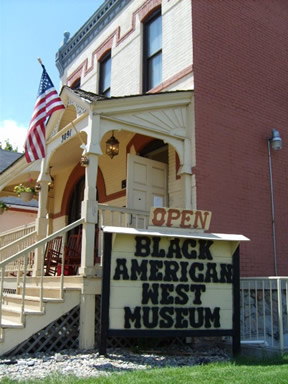By Andrea Juarez
 La Wanna Larson remembers the history lessons she received, or more aptly, didn’t receive in school, when growing up in Colorado Springs. She took field trips to Garden of the Gods, and learned about Helen Hunt Jackson and pioneers. Never, however, did she learn about the role of African Americans in settling the West. La Wanna Larson remembers the history lessons she received, or more aptly, didn’t receive in school, when growing up in Colorado Springs. She took field trips to Garden of the Gods, and learned about Helen Hunt Jackson and pioneers. Never, however, did she learn about the role of African Americans in settling the West.
“In the third grade I asked my teacher, ‘What about the Black people?’ and her response was that there were no Black people out here then,” says Larson, shaking her head. “They never said anything about people of color.”
Today, the 42-year-old is the executive director of the Black American West Museum at 3091 California St. in Five Points. She holds a bachelor’s degree in history and a master’s degree in nonprofit management, earned at the University of Nebraska-Omaha. Before coming to the museum in December 2004, she worked in politics as an aide to former Colorado State Senator John Evans.
Larson believes school-age children of all races still rarely learn about anything other than white pioneers and cowboys in the history of the West.
“That’s why what we do is so important,” says Larson. “Visitors learn about history that hasn’t been told – about Black soldiers, miners, cowboys, pioneers, explorers, and homesteaders.”
 The museum has a collection of over 35,000 donated and purchased items, including photographs, Buffalo Soldier uniforms, period furniture, and common frontiersman artifacts. Founded in 1971, the museum has been referenced as the No. 1 place to visit in foreign guidebooks. Larson says it’s popular with national and international tourists. The museum has a collection of over 35,000 donated and purchased items, including photographs, Buffalo Soldier uniforms, period furniture, and common frontiersman artifacts. Founded in 1971, the museum has been referenced as the No. 1 place to visit in foreign guidebooks. Larson says it’s popular with national and international tourists.
“I am honored to be leading this organization,” says Larson. “I have big shoes to fill, following Wallace Tollette, who was the executive director for nine years. Under her, the museum grew from a personal collection to an educational institution.”
Larson is the only paid staff in the volunteer-driven organization. In March 2006, about a year after she assumed the executive director position, she was diagnosed with stage-three breast cancer. In April 2006, she had a double mastectomy and spent most of the remaining year in and out of chemotherapy. In a few weeks she will learn if she is cancer-free. Surprisingly, Larson is upbeat about this period in her life.
“It was the best year of my life. It brought out the best qualities in me,” she says. “I couldn’t afford to get depressed. I try to keep it positive in life. The museum kept me going. My passion and love for it was a good distraction from the cancer and treatment.”
While she underwent chemotherapy, she was ordered to limit exposure to people, so she went behind the scenes orchestrating tasks and a slew of volunteers. Larson is thankful to all those who showed their support.
“My friends, board and husband were so supportive. People pitched in at home and here at the museum,” she says.
Her sister, Jaculine Spann, volunteered to fill in as executive director until the end of 2006, while Larson’s husband, Donald, spent endless hours at the museum. Her parents, Jack and Loris Spann from Colorado Springs, also worked many weekends. Even her 4-year-old daughter, Elizabeth, has developed a knack for giving tours.
“My family stepped in and helped, because they know how much this place means to me,” says Larson.
Shalavar Ward has been volunteering five months at the museum and says he continues to put in hours because of Larson.
“I have learned a lot about history and I enjoy what I do, but I got hooked on it because of La Wanna,” Ward says. “She’s a go-getter, and very dedicated to her work.”
Despite Larson’s health problems, she managed to institute many changes. She says most have been cosmetic, but in the museum business where aesthetics matter, such changes are vital. She had the building painted inside and out. She reorganized and structured all the exhibits. Also, three photo exhibits were added to the Black American West collection: “Colorado Women’s Hall of Fame,” “Faces of the West” and the “2006 Bill Pickett Invitational Rodeo."
Larson enhanced the museum’s marketing, as well. She changed the logo, overhauled the Web site and created new programs, such as the thematic afternoon teas, the first-Friday lectures that will start in June, and the youth program, “A Day in a Life of a Cowboy.”
Peter Chapman, museum board chair and policy advisor to Mayor John Hickenlooper, has worked with Larson for the last few years.
“La Wanna has brought stability and creativity to the executive director position, and has enabled the museum to move to the next level to become a local and regional cultural attraction,” explains Chapman about Larson’s invaluable contributions.
Larson’s immediate goals for the museum are to work to get broader recognition in the Denver metro area and statewide. She would also like to get educational programming about Blacks in the American West into Denver Public Schools, to help fill in any gaps in the regular history curriculum.
“I love it here,” she says. “It’s a challenge because sometimes the museum gets discounted by others and large institutions. But, if I can convince others to give us their time, I know that when they leave here, they will have learned something new. I know then I have done my job.”
Return To Top |
